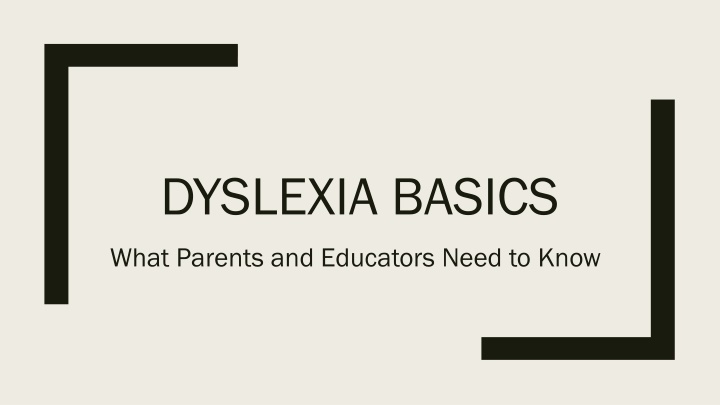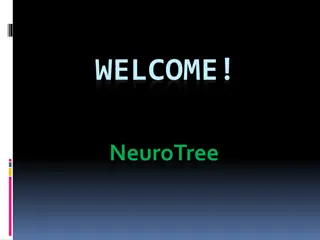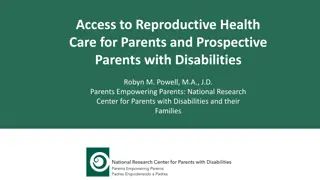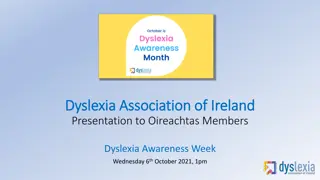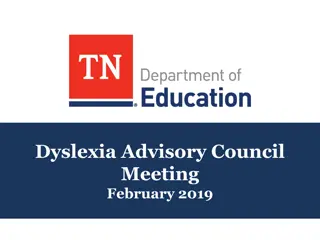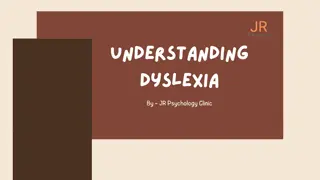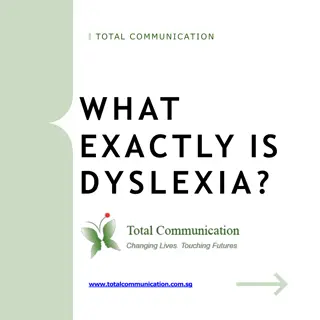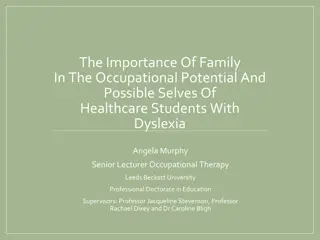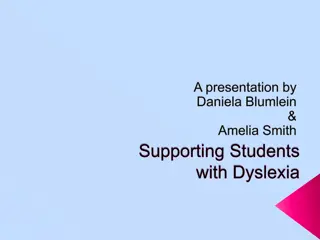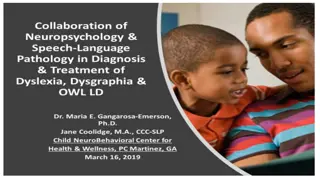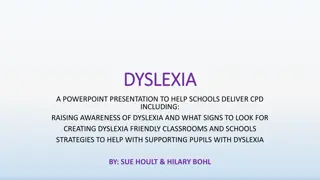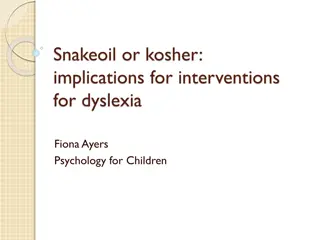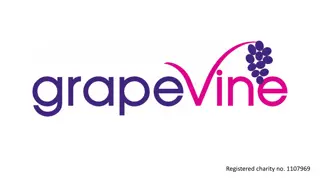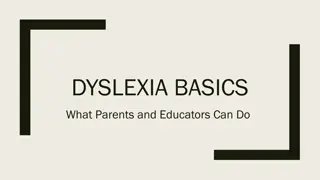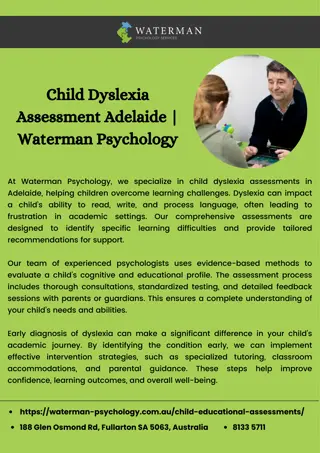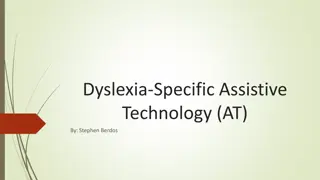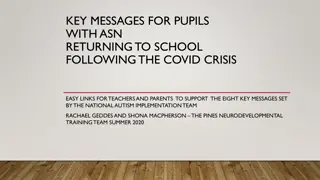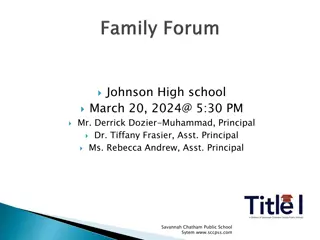Dyslexia Basics: What Parents and Educators Should Know
This content delves into the basics of dyslexia, providing crucial information for parents and educators. It covers key topics such as reading difficulties, important terms like phoneme and grapheme, and core misconceptions about dyslexia. The material also explores the causes of reading difficulties and emphasizes the phonological system as the core deficit in dyslexia. With insights from experts like Dr. Kathleen J. Brown from the University of Utah Reading Clinic, this resource aims to increase awareness and understanding of dyslexia.
Download Presentation

Please find below an Image/Link to download the presentation.
The content on the website is provided AS IS for your information and personal use only. It may not be sold, licensed, or shared on other websites without obtaining consent from the author.If you encounter any issues during the download, it is possible that the publisher has removed the file from their server.
You are allowed to download the files provided on this website for personal or commercial use, subject to the condition that they are used lawfully. All files are the property of their respective owners.
The content on the website is provided AS IS for your information and personal use only. It may not be sold, licensed, or shared on other websites without obtaining consent from the author.
E N D
Presentation Transcript
DYSLEXIA BASICS What Parents and Educators Need to Know
UNIVERSITY OF UTAH READING CLINIC Dr. Kathleen J. Brown www.uurc.org 801-265-3951
Take This to the Bank: Take This to the Bank: Good readers take in almost every word on the page. They recognize words at sight. With an unfamiliar word, they use spelling patterns to quickly chunk the word by syllable. Poor readers rely on context to identify words. Adams, 1990, Perfetti & Lesgold, 1979; Rayner & Pollatsek, 1987; Stanovich & Stanovich, 1995
black green black green red green blue black red red green blue green blue black red black green black green blue green blue red red green black
He had never seen dogs fight as these wxxxish cxxxxxxxx fxxxxt, and his first exxxxxxxxx txxxxt him an unfxxxxxxxble lxxxxx. It is true, it was a vixxxxxxx exxxxxxxxx, else he would not have lived to prxxit by it. Cxxxx was the vxxxxx. They were camped near the log store, where she, in her friendxx way, made adxxxxxx to a husky dog the size of a full-xxxxx wolf, thxxxx not half so large as xhe. Thxxx was no wxxxing, only a leap in like a flash, a metxx clip of teeth, a leap out exxxxly swift, and Cxxxx s face was ripped open from eye to jaw. 5
What What Causes Reading Difficulties? Causes Reading Difficulties? The Source(s) of Reading Difficulties are < <-----------------------------------------------------------------------------------> > Constitutional and/or (in the child) Environmental (outside the child) 6
Important Important Terms Terms Phoneme: Phoneme: An individual speech (/sh sh/, / /, /p/) sound. Grapheme: Grapheme: A letter or letter group that represents a speech sound or phoneme. (sh sh o p) Not synonymous w/letter (s s h h). Morpheme: Morpheme: The smallest linguistic unit in a word that has meaning. (shop + ed) 7
Dyslexia Basics Dyslexia Basics Dys = abnormal; not in a positive way Lex = word (Greek) Misconceptions (e.g., see backwards, words jump on the page, colored lenses, marching, eye training) (Greek) Core deficit is in language, specifically, the phonological system which causes difficulty matching speech speechsounds sounds to letter symbols. Math and oral language abilities normal or above 8
Does That Mean Dyslexics Dont Hear Well? Does That Mean Dyslexics Don t Hear Well? A dyslexic s auditory system is not not impaired. That is, the physiology of ears and hearing are within the normal range. A dyslexic s deficit lies in the BRAIN.
Could It Be a Problem with the Visual System? Could It Be a Problem with the Visual System? A saccade occurs when the eyes make a small jump from one fixation to the next. Dyslexics saccade like beginning readers (i.e., lots of regressions). When reading improves, saccades improve, but saccadic training does not improve reading. Dyslexia is not correlated with eye or eye movement problems.
Dyslexia: Not the Fault of the Visual System Dyslexia: Not the Fault of the Visual System Historically (and still), many believed that dyslexia was caused by visual problems WRONG! Reading is visually driven, but only in the sense that retinal images must be transmitted to the brain Once images get to the brain, decoding/word rec occur via non-visual cognitive systems (e.g., phonological) What look like visual probs (e.g., directionality) are sympotoms rather than causes
Visual Intervention for Dyslexics? No! Visual Intervention for Dyslexics? No! Given lack of scientific evidence, and high probability that visual treatment for dyslexia are theoretically flawed, the American Academy of Pediatrics & AETNA Insurance do not endorse and will not pay for these controversial treatments. http://pediatrics.aappublications.org/content/124/2/837 http://www.aetna.com/cpb/medical/data/1_99/0078.html
Dyslexia is a specific learning disability specific learning disability that is neurobiological neurobiological in origin. It is characterized by difficulties with accurate and/or fluent word recognition accurate and/or fluent word recognition and by poor spelling spelling and decoding decoding abilities. These difficulties typically result from a deficit in the phonological phonological component of language that is often often unexpected unexpected in relation to other cognitive abilities and the provision of effective classroom instruction. Secondary consequences Secondary consequences may include problems in reading comprehension and reduced reading experience that can impede growth of vocabulary vocabulary and background knowledge background knowledge.
Dyslexia is a specific learning disability that Dyslexia is a specific learning disability that is neurobiological in origin is neurobiological in origin This definition has been adopted by: International Dyslexia Association National Institute of Child Health & Human Development (US Department of Health & Human Services)
Dyslexia Dyslexia is not is not occurs in all socioeconomic levels occurs slightly more in boys than girls may occur in spite of good classroom instruction is resistant to intervention may occur with other disorders (e.g., ADD) not caused by a visual problem not caused by lack of motivation 15
A Non-Dyslexic Childs Journey in G1 b d /b/ /d/ Over time, speech sounds and graphemes processed simultaneously (automaticity). Result? No more mistakes! 16
A Dyslexic Childs Journey in G1 and On b d /b/ /d/ quit, quiet, quite ever, every, very ever and, said what, that 17
Is My Child Dyslexic? Is My Child Dyslexic? Timed Timed tests of letter-names or letter-sounds in K & early G1. Timed Timed phoneme awareness (e.g. wug, sim) tasks in early G1. Oral reading fluency, a timed timed test of reading rate and accuracy in connected text in G2 and up. Poor spelling well below grade level expectations Poor response to basic reading intervention 18
Identifying Reading Disability in Utah Identifying Reading Disability in Utah Utah Schools may use any of the following options: A. Response to Intervention B. Discrepancy (1.5 s.d.) between reading achievement & intellectual ability e.g., IQ = 100 WRMT = 78 C. Combination of A & B above 19
The Team Approach The Team Approach Student Parents/Guardians Classroom Teacher School Psychologist Speech & Language Pathologist Academic Therapist Content Area Teachers Reading Specialist Intervention Specialist Occupational Therapist 20
Students Who Do Not Qualify for an IEP Students Who Do Not Qualify for an IEP For students with moderate reading difficulties who do not have IEPs, and who are unlikely to qualify for an IEP, a 504 Plan can be a life-saver! A 504 Plan will allow accommodations that help a junior high/high school student to keep up with coursework and demonstrate optimum performance on standardized tests (e.g., ACT) Teachers need to be in the 504 loop for the plan to work well. A 504 Plan is not cheating! 21
UURC Services UURC Services Basic Assessment Battery - $50 Intensive Assessment Battery - $100 after intervention Basic Intervention - 45 minutes 2x week Intensive Intervention (Wilson) - 75 minutes 2x week Professional Development for Educators (basic, intensive intervention) 22
What Can a Parent Do at Home? What Can a Parent Do at Home? Home Word Charts - http://www.uurc.utah.edu/General/HomeWord.php Repeated Readings - http://www.uurc.utah.edu/General/Forms-Charts.php More, more, and more! http://www.uurc.utah.edu/Parents/ParentLinks.php
For More Information For More Information The International The International Dyslexia Association Dyslexia Association 40 York Road 4th Floor Baltimore, Maryland 21204 www.interdys.org 1-800-ABCD123 410-296-0232 25
